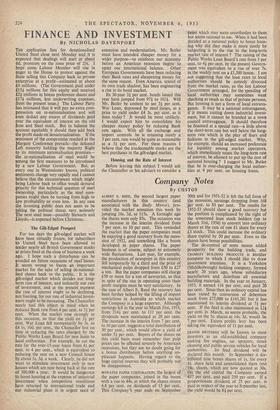INVESTMENT FINANCE AND
DAVENPORT By NICHOLAS THE application lists for denationalised United Steel close next Monday and it is expected that dealings will start at about 6d. premium on the issue price of 25s. I hope some Labour Member will rise in anger in the House to protest against the State selling this Company back to private enterprise at a profit—estimated at about £4 millions. (The Government paid under £151 millions for this equity and received £21 millions in bonus preference shares and £171 millions, less underwriting expenses, from the present issue.) The Labour Party has intimated that it will pay no extra com- pensation on re-nationalisation and will even deduct any excess of dividends paid over the equivalent of interest on the old iron and Steel stock. But to balance the account equitably it should then add back the profit made on-denationalisation. If the sentiment of the compromise reached at the Margate Conference prevails—the defeated Left minority holding the majority Right to its minimum nationalisation promises— the re-nationalisation of steel would be among the first measures to be introduced by a new Labour Government. But, as every one in Westminster knows, political sentiments change very rapidly and I cannot believe that the circumstances which might bring Labour back to office would demand priority for this technical question of steel Ownership, particularly as the steel com- panies might then be turning from .high to low profitability or even loss. In any case the investing public does not seem to be taking the political threat very seriously The next steel issue—possibly Stewarts and Lloyds—is expected before Christmas.
The Gilt-Edged Prospect • For ten days the gilt-edged market will have been virtually frozen, for subscribers to United Steel have been allowed to tender nearly all British Government stocks at prices fixed at the close of business a week ago. I hope such a disturbance can be avoided on future occasions of steelissues. It seems wrong to freeze an important market for the sake of selling de-national- ised shares back to the public. It is the gilt-edged market which decides our long- term rate of interest, and indirectly our rate of investment, and at the present moment the rate of interest ought to be declining, not freezing, for our rate of industrial invest- ment ought to be increasing. The Chancellor surely had this object in mind when he reduced Bank rate from 4 per cent. to 31 per cent. When the market rose strongly to this occasion, so that the yield on 31 per cent. War Loan fell momentarily by 3s. to £4 1 s. 10d. per cent., the Chancellor lost no time in reducing the rates charged by the Public Works Loan Board for new loans to local authorities. For example, he cut the rate for the over-15-year loans from 41 per cent. to 4 per cent., which is equivalent to reducing the rent on a new Council house by about ls. 3d. a week. Clearly, he did not Want to stimulate investment only in new houses which are now being built at the rate of 300,000 a year. It would be dangerous to boost housing at the expense of industrial investment when competitive conditions have returned to international trade and our industrial plant is in urgent need of extension and modernisation. Mr. Butler must have intended cheaper money for a wider purpose—to reinforce our economy before an American recession begins to upset our international balance. Other European Governments have been reducing their Bank rates and cheapening money for the same reason. Even America, scared of its own trade shadow, has been engineering a rise in its bond market.
Its 30-year 31 per cent. bonds issued this year have jumped from 971 to 1021. Will Mr. Butler be content to see. 31 per cent. War Loan, depressed by steel issues, at a price to yield under £4 3s. per cent. as it does today ? It would be most unlikely. I would expect him to consolidate his cheaper money policy by reducing Bank rate again. With all' the exchange and import controls he is retaining surely a 3 per cent. rate would be quite as reasonable as a 31 per cent. For these reasons I believe that the irredeemable stocks are the best purchases in the gilt-edged market.
Housing and the Rate of Interest Before leaving this subject I would ask the Chancellor or his advisers to consider a point which may seem unorthodox to them but seems rational to me. When it had been decided as a national policy to boost hous- ing why did they make it more costly by subjecting it to the rise in the long-term market rate of interest ? The raising of the Public Works Loan Board's rate from 3 per cent. to 41 per cent. by the present Govern- ment was equivalent to a rise of over 7s. in the weekly rent 'on a £1,500 house. I am not suggesting that the loan rates to local authorities should be entirely divorced from the market rates, as the last Labour Government arranged, for the spending of local authorities may sometimes want checking as much as that of private persons. But housing is not a form of local extrava- gance. It may be a national extravagance, if it means cutting down industrial invest- ment, but it cannot be branded as a town council extravagance. It should therefore be financed at a special rate—a little above the short-term rate but well below the long- term rate which is the play of fears and fashions in the gilt-edged market. Why, for example, should an increased preference for liquidity among market .operators, which immediately raises the long-term rate of interest, be allowed to put up the cost of national housing ? I suggest to Mr. Butler that he is over-charging the local author- ities at 4 per cent. on housing loans.


































 Previous page
Previous page